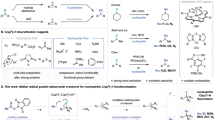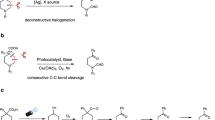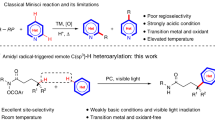Abstract
Carbon–carbon (C–C) bond formation is paramount in the synthesis of biologically relevant molecules, modern synthetic materials and commodity chemicals such as fuels and lubricants. Traditionally, the presence of a functional group is required at the site of C–C bond formation. Strategies that allow C–C bond formation at inert carbon–hydrogen (C–H) bonds enable access to molecules that would otherwise be inaccessible and the development of more efficient syntheses of complex molecules1,2. Here we report a method for the formation of C–C bonds by directed cleavage of traditionally non-reactive C–H bonds and their subsequent coupling with readily available alkenes. Our methodology allows for amide-directed selective C–C bond formation at unactivated sp3 C–H bonds in molecules that contain many such bonds that are seemingly indistinguishable. Selectivity arises through a relayed photoredox-catalysed oxidation of a nitrogen–hydrogen bond. We anticipate that our findings will serve as a starting point for functionalization at inert C–H bonds through a strategy involving hydrogen-atom transfer.
This is a preview of subscription content, access via your institution
Access options
Subscribe to this journal
Receive 51 print issues and online access
$199.00 per year
only $3.90 per issue
Buy this article
- Purchase on Springer Link
- Instant access to full article PDF
Prices may be subject to local taxes which are calculated during checkout



Similar content being viewed by others
References
Gutekunst, W. R. & Baran, P. S. C–H functionalization logic in total synthesis. Chem. Soc. Rev. 40, 1976–1991 (2011)
Yamaguchi, J., Yamaguchi, A. D. & Itami, K. C–H bond functionalization: emerging synthetic tools for natural products and pharmaceuticals. Angew. Chem. Int. Ed. 51, 8960–9009 (2012)
Newhouse, T. & Baran, P. S. If C–H bonds could talk: selective C–H bond oxidation. Angew. Chem. Int. Ed. 50, 3362–3374 (2011)
Lawrence, J. D., Takahashi, M., Bae, C. & Hartwig, J. F. Regiospecific functionalization of methyl C–H bonds of alkyl groups in reagents with heteroatom functionality. J. Am. Chem. Soc. 126, 15334–15335 (2004)
Shabashov, D. & Daugulis, O. Auxiliary-assisted palladium-catalyzed arylation and alkylation of sp2 and sp3 carbon–hydrogen bonds. J. Am. Chem. Soc. 132, 3965–3972 (2010)
He, J. et al. Ligand-controlled C(sp3)–H arylation and olefination in synthesis of unnatural chiral α-amino acids. Science 343, 1216–1220 (2014)
Jiang, H., He, J., Liu, T. & Yu, J.-Q. Ligand enabled γ-C(sp3)–H olefination of amines: en route to pyrrolidines. J. Am. Chem. Soc. 138, 2055–2059 (2016)
Zhang, F.-L., Hong, K., Li, T.-J., Park, H. & Yu, J.-Q. Functionalization of C(sp3)–H bonds using a transient directing group. Science 351, 252–256 (2016)
Topczewski, J. J., Cabrera, P. J., Saper, N. I. & Sanford, M. S. Palladium-catalysed transannular C–H functionalization of alicyclic amines. Nature 531, 220–224 (2016)
Chen, M. S. & White, M. C. Combined effects on selectivity in Fe-catalyzed methylene oxidation. Science 327, 566–571 (2010)
Schmidt, V. A., Quinn, R. K., Brusoe, A. T. & Alexanian, E. J. Site-selective aliphatic C–H bromination using N-bromoamides and visible light. J. Am. Chem. Soc. 136, 14389–14392 (2014)
McNally, A., Haffemayer, B., Collins, B. S. L. & Gaunt, M. J. Palladium-catalysed C–H activation of aliphatic amines to give strained nitrogen heterocycles. Nature 510, 129–133 (2014)
Archambeau, A. & Rovis, T. Rhodium(III)-catalyzed allylic C(sp3)–H activation of alkenyl sulfonamides: unexpected formation of azabicycles. Angew. Chem. Int. Ed. 54, 13337–13340 (2015)
Robertson, J., Pillai, J. & Lush, R. K. Radical translocation reactions in synthesis. Chem. Soc. Rev. 30, 94–103 (2001)
Cekovic, Z. Reactions of carbon radicals generated by 1,5-transposition of reactive centers. J. Serb. Chem. Soc 70, 287–318 (2005)
Zard, S. Z. Recent progress in the generation and use of nitrogen-centered radicals. Chem. Soc. Rev. 37, 1603–1618 (2008)
Nikishin, G. I., Troyansky, E. I. & Lazareva, M. I. Regiospecific oxidative cyclization of N-methylsulfonylamines into pyrrolidines. Tetrahedron 41, 4279–4288 (1985)
Noble, A. & MacMillan, D. W. C. Photoredox α-vinylation of α-amino acids and N-aryl amines. J. Am. Chem. Soc. 136, 11602–11605 (2014)
Zhang, J., Li, Y., Zhang, F., Hu, C. & Chen, Y. Generation of alkoxy radicals by photoredox catalysis enables selective C(sp3)–H functionalization under mild reaction conditions. Angew. Chem. Int. Ed. 55, 1872–1875 (2016)
Li, J. J. Named Reactions for Functional Group Transformation 423–437 (Wiley, 2007)
Lowry, M. S. et al. Single-layer electroluminescent devices and photoinduced hydrogen production from an ionic iridium(III) complex. Chem. Mater. 17, 5712–5719 (2005)
Nechab, M., Mondal, S. & Bertrand, M. P. 1,n-Hydrogen-atom transfer (HAT) reactions in which n ≠ 5 an updated inventory. Chem. Eur. J. 20, 16034–16059 (2014)
Tassone, D. M., Boyce, E., Guyer, J. & Nuzum, D. Pregabalin: a novel γ-aminobutyric acid analogue in the treatment of neuropathic pain, partial-onset seizures, and anxiety disorders. Clin. Ther. 29, 26–48 (2007)
Choi, G. J. & Knowles, R. R. Catalytic alkene carboaminations enabled by oxidative proton-coupled electron transfer. J. Am. Chem. Soc. 137, 9226–9229 (2015)
Miller, D. C., Choi, G. J., Orbe, H. S. & Knowles, R. R. Catalytic olefin hydroamidation enabled by proton-coupled electron transfer. J. Am. Chem. Soc. 137, 13492–13495 (2015)
Acknowledgements
We thank NIGMS (GM80442) for support. J.C.K.C. thanks the Croucher Foundation (Hong Kong) for support. We thank M. Burns (CSU) for technical assistance. We thank R. R. Knowles (Princeton University) for sharing results before publication.
Author information
Authors and Affiliations
Contributions
T.R. and J.C.K.C. conceived the concept and prepared the manuscript. T.R. directed the investigation. J.C.K.C. developed and studied the reaction.
Corresponding author
Ethics declarations
Competing interests
The authors declare no competing financial interests.
Additional information
Reviewer Information
Nature thanks A. Studer and the other anonymous reviewer(s) for their contribution to the peer review of this work.
Supplementary information
Supplementary Information
This file contains Supplementary Text and Data – see contents page for details. (PDF 6073 kb)
Rights and permissions
About this article
Cite this article
Chu, J., Rovis, T. Amide-directed photoredox-catalysed C–C bond formation at unactivated sp3 C–H bonds. Nature 539, 272–275 (2016). https://doi.org/10.1038/nature19810
Received:
Accepted:
Published:
Issue Date:
DOI: https://doi.org/10.1038/nature19810
This article is cited by
-
Enantioselective synthesis of β- and α-amino ketones through reversible alkane carbonylation
Nature Synthesis (2024)
-
Acceptorless cross-dehydrogenative coupling for C(sp3)-H heteroarylation mediated by a heterogeneous GaN/ketone photocatalyst/photosensitizer system
Communications Chemistry (2023)
-
Photoenzymatic enantioselective intermolecular radical hydroamination
Nature Catalysis (2023)
-
Transition metal-free visible light photoredox-catalyzed remote C(sp3)−H borylation enabled by 1,5-hydrogen atom transfer
Communications Chemistry (2023)
-
Photochemical diversification of strong C(sp3)–H bonds enabled by allyl bromide and sodium fluoride
Nature Synthesis (2023)
Comments
By submitting a comment you agree to abide by our Terms and Community Guidelines. If you find something abusive or that does not comply with our terms or guidelines please flag it as inappropriate.



